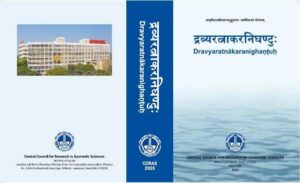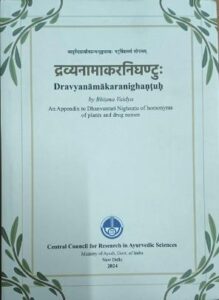NewzVille Desk
To preserve India’s rich legacy in traditional medicine, the Central Council for Research in Ayurvedic Sciences (CCRAS), under the Ministry of Ayush, has revived two rare and significant Ayurvedic manuscripts—Dravyaratnākara Nighaṇṭu and Dravyanamākara Nighaṇṭu.
Both the publications unveiled during a special event organized by the RRAP Central Ayurveda Research Institute at Ayurveda Mahavidyalaya, Sion, Mumbai. The event was graced by Prof. Vd. Rabinarayan Acharya, Director General, CCRAS, New Delhi.
The manuscripts were critically edited and translated by renowned manuscriptologist and veteran Ayurveda expert, Dr. Sadanand D. Kamat of Mumbai.
Ranjit Puranik, President, Ayurvidya Prasarak Mandal and Managing Director, Shri Dhootapeshwar Limited; Dr. Ravi More, Principal, Ayurveda Mahavidyalaya, Sion; Dr. Shyam Nabar and Dr. Ashanand Sawant from Ayurvidya Prasarak Mandal; Dr. R. Govind Reddy, Assistant Director (Ayu), CARI, Mumbai; and other dignitaries were also present on the occasion.
Delivering an insightful talk on preserving Ayurveda’s manuscript heritage, Prof. Vd. Rabinarayan Acharya said that “These texts are not just historical artefacts—they are living knowledge systems that can transform contemporary healthcare approaches when studied and applied thoughtfully”.
Both the editions will serve as invaluable resources for students, researchers, academicians, and Ayurveda practitioners, further inspiring scholarly exploration and deeper engagement with India’s classical medical literature.
By digitising, editing, and interpreting these invaluable works, CCRAS and its collaborators are not only safeguarding literary treasures but also enriching India’s traditional healthcare system with validated ancient insights.

Dravyaratnākara Nighaṇṭu:
Authored by Mudgala Paṇḍita in 1480 AD, this previously unpublished lexicon consists of eighteen chapters offering in-depth knowledge on drug synonyms, therapeutic actions, and medicinal properties. A widely referenced text in Maharashtra until the 19th century, it draws from classical Nighaṇṭus like Dhanvantari and Raja Nighaṇṭu while documenting numerous novel medicinal substances from plant, mineral, and animal origins. This critical edition, revived by Dr. S. D. Kamat, is a monumental contribution to Dravyaguna and allied Ayurvedic disciplines.

Dravyanamākara Nighaṇṭu:
Attributed to Bhisma Vaidya, this unique work serves as a standalone appendix to the Dhanvantari Nighaṇṭu, focusing exclusively on homonyms of drug and plant names—a complex area of study vital to Ayurveda. Encompassing 182 verses and two colophon verses, the text has been meticulously edited and commented upon by Dr. Kamat, enhancing its utility for scholars of Rasashastra, Bhaishajya Kalpana, and classical Ayurvedic pharmacology.
Dr. Kamat, known for his authoritative work on Saraswati Nighaṇṭu, Bhāvaprakāsha Nighaṇṭu, and Dhanvantari Nighaṇṭu, once again brings his deep scholarship and commitment to preserving India’s Ayurvedic heritage.





